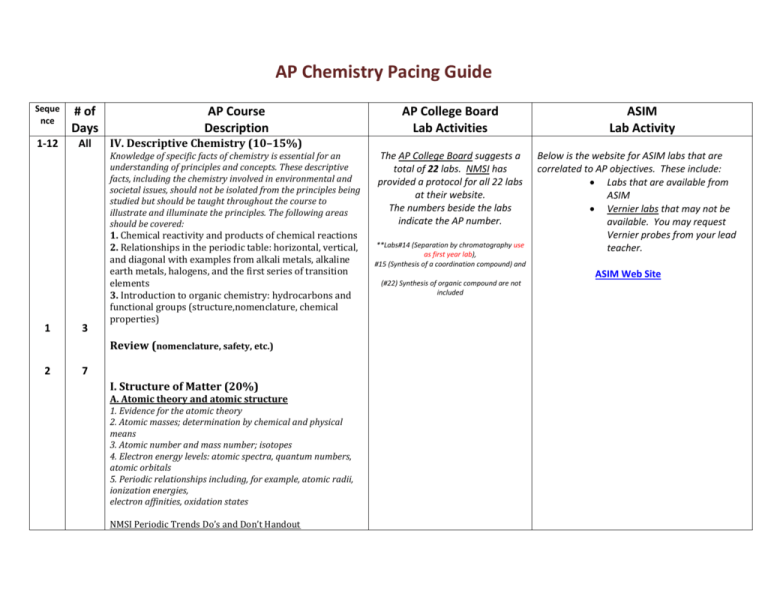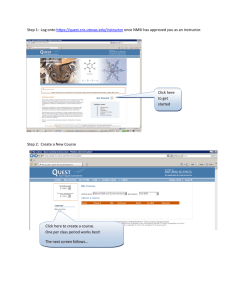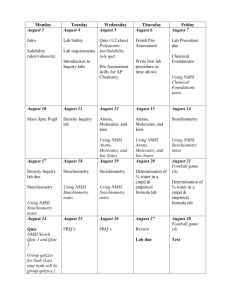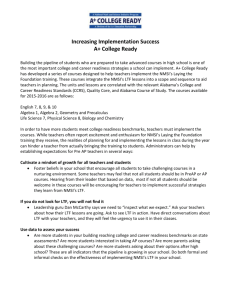AP Chemistry Pacing Guide Sequence # of Days AP Course
advertisement

AP Chemistry Pacing Guide Seque nce # of Days 1-12 All 1 3 AP Course Description ASIM Lab Activity IV. Descriptive Chemistry (10–15%) Knowledge of specific facts of chemistry is essential for an understanding of principles and concepts. These descriptive facts, including the chemistry involved in environmental and societal issues, should not be isolated from the principles being studied but should be taught throughout the course to illustrate and illuminate the principles. The following areas should be covered: 1. Chemical reactivity and products of chemical reactions 2. Relationships in the periodic table: horizontal, vertical, and diagonal with examples from alkali metals, alkaline earth metals, halogens, and the first series of transition elements 3. Introduction to organic chemistry: hydrocarbons and functional groups (structure,nomenclature, chemical properties) Review (nomenclature, safety, etc.) 2 AP College Board Lab Activities 7 I. Structure of Matter (20%) A. Atomic theory and atomic structure 1. Evidence for the atomic theory 2. Atomic masses; determination by chemical and physical means 3. Atomic number and mass number; isotopes 4. Electron energy levels: atomic spectra, quantum numbers, atomic orbitals 5. Periodic relationships including, for example, atomic radii, ionization energies, electron affinities, oxidation states NMSI Periodic Trends Do’s and Don’t Handout The AP College Board suggests a total of 22 labs. NMSI has provided a protocol for all 22 labs at their website. The numbers beside the labs indicate the AP number. **Labs#14 (Separation by chromatography use as first year lab), #15 (Synthesis of a coordination compound) and (#22) Synthesis of organic compound are not included Below is the website for ASIM labs that are correlated to AP objectives. These include: Labs that are available from ASIM Vernier labs that may not be available. You may request Vernier probes from your lead teacher. ASIM Web Site NMSI Atomic Structure and Periodicity Quizzes NMSI Atomic Structure and Periodicity AP FR Worksheet NMSI Unit Exam: Atomic Structure 3 10 B. Chemical bonding 1. Binding forces a. Types: ionic, covalent, metallic, hydrogen bonding, van der Waals (including London dispersion forces) b. Relationships to states, structure, and properties of matter c. Polarity of bonds, electronegativities 2. Molecular models a. Lewis structures b. Valence bond: hybridization of orbitals, resonance, sigma and pi bonds c. VSEPR 3. Geometry of molecules and ions, structural isomerism of simple organic molecules and coordination complexes; dipole moments of molecules; relation of properties to structure C. Nuclear chemistry: nuclear equations, half-lives, and radioactivity NMSI AP FR Bonding Worksheet NMSI Bonding Quizzes NMSI Unit Exam: Bonding 4 5 III. Reactions (35–40%) *Determination of % Water/Empirical Formulas (01, 02, 16) suggest first year lab Empirical Formula of a Hydrate, Bunsen burner B. Stoichiometry 1. Ionic and molecular species present in chemical systems: net ionic equations 2. Balancing of equations, including those for redox reactions 3. Mass and volume relations with emphasis on the mole concept, including empirical formulas and limiting reactants *Determination of Mass/Mole Relationship (09) suggest first year lab Mass/Mole Relationship in a Reaction NMSI Stoichiometry AP FR Worksheet NMSI Stoichiometry Quizzes NMSI Unit Exam Stoichiometry 5 8 Net Ionic Lab No lab; use NMSI protocol A.. Reaction types 6 5 1. Acid-base reactions; concepts of Arrhenius, Brønsted-Lowry, and Lewis; coordination complexes; amphoterism 2. Precipitation reactions 3. Oxidation-reduction reactions a. Oxidation number b. The role of the electron in oxidation-reduction *Determination of Electrochemical Series (20) NMSI: Writing Net Ionic Equation Worksheet NMSI: Reaction Types Quizzes *Measurements Using Electrolytic Cells and Electroplating (21) c. Electrochemistry: electrolytic and galvanic cells; Faraday’s laws; standard half-cell potentials; Nernst equation; prediction of the direction of redox reactions 7 7 NMSI Electrochemistry AP FR Worksheet NMSI Electrochemistry Quizzes NMSI Unit Exam: Chemical Rxns and Electrochemistry *Determination of Concentration by Redox Titration (08) Corrosion Cell Lab voltage probes and Lab Quest usage No lab; use NMSI protocol Redox Titration e E. Thermodynamics 1. State functions 2. First law: change in enthalpy; heat of formation; heat of reaction; Hess’s law; heats of vaporization and fusion; calorimetry 3. Second law: entropy; free energy of formation; free energy of reaction; dependence of change in free energy on enthalpy and entropy changes *Determination of Enthalpy change associated with a reaction (13) Enthalpy of Reaction temperature probe and Lab Quest 4. Relationship of change in free energy to equilibrium constants and electrode 8 8 NMSI Thermodynamics FR Worksheet NMSI Thermodynamics and Thermochemistry Quizzes NMSI Unit Exam: Thermochemistry and Thernodynamics D. Kinetics *Determination of the Rate, Order, and Activation Energy of a reaction (12) Crystal Violet Lab quest and colorimetry probe used; same procedure as Vernier except activation energy 1. Concept of rate of reaction 2. Use of experimental data and graphical analysis to determine reactant order, rate constants, and reaction rate laws 3. Effect of temperature change on rates 4. Energy of activation; the role of catalysts 5. The relationship between the rate-determining step and a mechanism NMSI Kinetics AP FR Worksheets NMSI Using the Graphing Calculator NMSI Kinetics Quizzes NMSI Unit Exam: Kinetics 9 12 *Colorimetric or spectrophotometric analysis and determination of Keq (10, 17) Determination of Keq LabQuest and colorimetry probe; same procedure as Vernier C. Equilibrium 1. Concept of dynamic equilibrium, physical and chemical; Le Chatelier’s principle;equilibrium constants 2. Quantitative treatment a. Equilibrium constants for gaseous reactions: Kp, Kc (2) Solubility product constants (Ksp) and their application to precipitation and the dissolution of slightly soluble compounds NMSI General Kc, Kp, and Solubility AP FR Worksheets NMSI General Kc, Kp, Solubility Quizzes NMSI Unit Exam: General and Solubility Equilibrium b. Equilibrium constants for reactions in solution (1) Constants for acids and bases; pK; pH (3) Common ion effect; buffers; hydrolysis *Standardization of NaOH and A-B Titration (06, 07) Standardization of NaOH *Determination of Appropriate Indicators and Buffers (11, 19) No lab; use NMSI protocol 10 5 NMSI: Buffers Made Easy NMSI Acid Base Equilibrium Worksheet NMSI Acid Base Equilibrium Quizzes NMSI Unit Exam: Acid Base Buffer Equilibrium *Determining the Molar Volume of a Gas (05) II. States of Matter (20%) *Determination of Molar Mass by Vapor Density (03) suggest first ;year 1. Laws of ideal gases a. Equation of state for an ideal gas b. Partial pressures 2. Kinetic molecular theory a. Interpretation of ideal gas laws on the basis of this theory b. Avogadro’s hypothesis and the mole concept lab A. Gases No lab; use NMSI protocol No lab; use NMSI protocol NMSI Gases AP FR Worksheet NMSI Gases Quizzes NMSI Unit Exam: Gases 11 5 B. Liquids and solids 1. Liquids and solids from the kinetic-molecular viewpoint 2. Phase diagrams of one-component systems 3. Changes of state, including critical points and triple points 4. Structure of solids; lattice energies NMSI AP FR States of Matter Worksheet NMSI States of Matter Quizzes NMSI Unit Exam: States of Matter C. Solutions 1. Types of solutions and factors affecting solubility *Determination of Molar Mass by Freezing Point Depression (04) Freezing Pt. Depression Mel-Temps 12 5 2. Methods of expressing concentration (use of normalities is not tested) 3. Raoult’s law and colligative properties (nonvolatile solutes); osmosis 4. Nonideal behavior (qualitative aspects) NMSI AP FR Solutions Worksheet NMSI Solutions Quizzes NMSI Unit Exam: Solutions 13 4 Review / Mock Exam V. Laboratory (5–10%) Suggest first year lab





